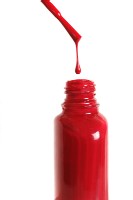10 Sparkling Nail Polish Facts
Makeup Trivia ¢ The most expensive nail polish in the world is made out of platinum, the introductory bottle is also made out of this cool metal and it is valued at $55,000. Limited edition bottles are valued at $250.00
¢ The most expensive nail polish in the world is made out of platinum, the introductory bottle is also made out of this cool metal and it is valued at $55,000. Limited edition bottles are valued at $250.00
¢ One of the common chemicals found in nail polish is dibutyl phthalate. The European Union has banned this chemical. Manufactures are removing this chemical and reformulating the polish.
¢ An unopened bottle of nail polish is reported to have a shelf life of 1 year.
¢ Nail polish remover is one product that has the longest shelf life – it never expires.
¢ Tiny platelets of aluminum, copper, gold, zinc and other metals gives nail polish the reflective metallic pigments.
¢ The color of nail polish falls into two categories: pigment and colorant. Pigment relates to an organic and inorganic molecule that is untouched by its vehicle. Colorant is a broader category it includes anything that imparts color to an underlying layer of material.
¢ Pearlescent nail polishes are typically composed of thin, translucent platelets coated with metal oxides.
¢ Sizes of the platelets used gives different visual effects. Large mica platelets give off larger sparkles, while finer and smaller platelets attain a silky or frosted look.
¢ Nail polish was used as a tool to identify leaf fossils in the Pacific Northwest.
¢ Painted nails were not always culturally accepted in some regions of the U.S. in the 1950’s, bright colored polishes such as red were considered promiscuous and all nail polish must be removed on Sundays before religious worship.

Tip: If you get a run in your pantyhose, stop it with a dab of clear nail polish. It works!
[…] https://www.avivadirectory.com/trivia/4-10-sparkling-nail-polish-facts/ […]